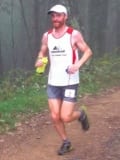I was offered a position in early March teaching a trail running class to a small group of middle-school kids. I excitedly took the gig and we finished up our last class of the school year this past week. My primary intention with this class was to teach the kids about the aspects of running that aren’t related to racing. We weren’t going to train for anything, or focus on becoming faster runners, but instead we were just going to go out and run, have fun, and enjoy the amazing trail system we are fortunate to have here in Alaska.
The first day of class I noticed a lot of blank stares when I was describing this intention to the kids. I couldn’t tell if maybe they were not listening to me, or if maybe I was confusing them. It turns out I was totally ‘preaching to the choir,’ and I don’t know that it had ever occurred to any of them that one could get caught up putting too much of their running focus on racing, or more specifically that one could neglect to pay enough attention to the non-racing aspects of running. Through this experience I have come to realize that the marriage of running and racing is mostly something we create as adults.
I have also made it a small part of my Alaska Mountain Ultrarunning Camps to show the adult participants about the importance of putting focus on the non-racing aspects of running, even for someone who may be a very avid and devoted racer. I think most of them come away with a bit better sense of this idea, but over these past few months I have come to learn that 11- and 12-year-old kids understand this much better than most adults. They haven’t yet been taught to automatically group running and racing together in the same way that most adults tend to do. In other words, they effectively already knew everything I set out to teach them in this class.
In this sense it made for a three-month class in which I was more the student and the kids were the teachers. We would meet every Thursday and I would choose where we would go running, but it was always up to them how we would run. Some days they would jump out of the car at the trailhead and begin sprinting up the 20% slopes which nearly all the trails in Juneau start with. Other days they would walk lazily up a nearly flat trail, and then only begin running because one of them decided to play tag with the others. As winter turned into spring, and the temperatures began to rise, water became a large part of our runs. A small stream was not something to quickly hop across and forget about, but instead it was a drinking fountain, a swimming pool, or a water fight waiting to happen. Bridges were not something you used to get across a small ravine, but instead something to hide under to try to playfully scare those coming from behind.
I’ve been a huge fan of this kind of spontaneous running for quite some time now, but it was educational, inspiring, and magical to see how natural it comes to kids this age. Not once after that first day of class did I have to say anything to them to guide them in the direction of giving ample attention to the non-racing aspects of running. Because we were not running any races as part of this class it never even crossed their minds to focus on anything that would have to do with racing.
I’m not in any way implying that it’s a bad thing to focus our running on racing, but as we grow up into adults it becomes less and less ‘normal’ to run unless you also race. Because of this reality I think most adults often have a hard time seeing running as something that has a life of its own outside of racing. On the other hand, nearly all kids run in some way in their daily life, but most of them do not race. Because of this they need little to no persuasion to be able to separate out the aspects of running that are related to racing and those which are not. I was able to learn a lot from my experience of teaching these kids, and I consider myself very fortunate to have been a part of this class.
As adults it’s easy to assume that we know more than kids, just as many kids assume they know more than adults. The truth is though, that knowledge is much more a qualitative notion than a quantitative one, and is constantly ebbing and flowing throughout our lives. We have little to no understanding of certain things which we once knew quite well, and conversely there are many things we will come to know that we have no awareness of right now.
In light of all of this, if you are an avid runner, I highly recommend paying close attention the next time you have the chance to run with children. You may feel like there are dozens of things you can teach them, and there probably are, but if you are open to it you will also find that there are numerous things they can teach you.
Call for Comments (from Meghan)
- What have you learned about running from children? Have they taught you to notice different things on the trails? Have they shown you how to move in a different way?
- How closely do you associate trail running with trail racing? How often when you are running are you thinking about racing, and how often are you focusing on the independent act of ‘just’ running?
